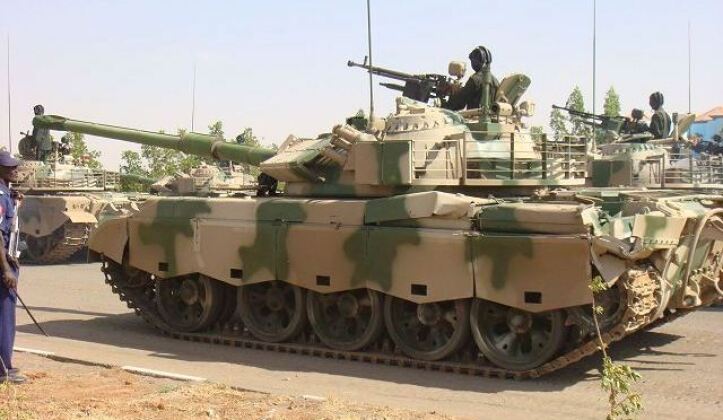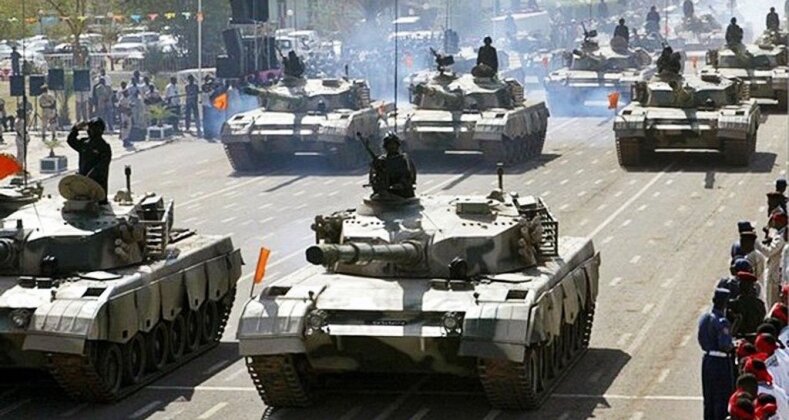News
Just How Powerful Are Sudan’s Tank Forces? On the Frontlines Today Against Paramilitary Resistance
Engagements from April 15 between the Sudanese Military and the country’s leading paramilitary force the Rapid Support Forces (RSF) has raised questions regarding the capabilities of the Army’s ground warfare capabilities, with unverified reports emerging from the country of heavy losses among tank units in particular. Sudanese tanks were deployed to the capital Khartoum in the weeks preceding the outbreak of hostilities, which was widely interpreted as a show of force against the RSF, although the militia’s anti tank capabilities have reportedly been formidable. The ongoing hostilities, the outcome of which remains highly uncertain, make assessment of Sudanese armoured warfare capabilities highly relevant. The Sudanese Army’s tank units are almost exclusively formed of derivatives of the T-54/55 tank, a class which first entered service in 1948, which remains the most mass produced tank in history and the most widely used in the world today due to its very low maintenance needs. The tanks have been sourced from Soviet successor states, namely Russia and Belarus, as well as from China and from indigenous production lines.

Sudan acquired its first Soviet tanks in 1958 with the delivery of 20 T-34 tanks from Egypt, which had been acquired by the Egyptian Army second hand from the Soviet Union before being passed onto its southern neighbour. The vehicles provided key experience in operating armour which was still relatively modern for its time. Sudan acquired its first T-54/55 tanks in 1969 with 100 of the vehicles delivered second hand from the Soviet Union after an order had been made the previous year. These vehicles are thought to still be in service in some capacity. In the 1970s. China emerged as a leading supplier of armour to Sudan, and having begun producing the Type 59 tank as a derivative of the T-54/55 in 1958, it made the first deliveries to Sudan in 1972 with a package estimated at 50 vehicles. These were preceded by deliveries of an estimated 70 Type 62 light tanks from 1971-73, which were also Type 59 derivatives but with lighter armour and smaller main guns among other weight reducing modifications.
After the Cold War’s end Sudan placed an order in 1999 for 70 more T-55s from Belarus, namely the enhanced T-55AM-2 variant, which were acquired second hand and modernised significantly with Russian support. The tanks received V-55B tanks from Russia which were delivered the following decade. T-55s were at the time being retired in their thousands from the armed forces of Soviet successor states, and could be acquired at negligible cost. Sudan strongly capitalised on the massive equipment surpluses post Soviet states fielded to make major acquisitions, which included MiG-29 fighters purchased for just $10 million each with associated spare parts and armaments, to Belarusian and Russian Mi-24 attack helicopters.

Sudan’s T-54/55 acquisitions culminated in the setting up of a production line for the Chinese Type 59D, which was built under license from 2010 as the Al Zubair tank. These currently form the backbone of the fleet with 50-100 thought to have been built. The class represents a significant improvement over the basic T-54/55 design, with relatively modern fire controls including ballistic computers with laser range finders and stabilised images displays, thermal imagers, and compatibility with armour piercing fin stabilised discarding sabot rounds, although its armour protection and rifled gun were still obsolete for modern tank on tank engagements when it entered service. The tanks were built primarily for counterinsurgency and infantry support.
The elite of the Sudanese Army’s tank units is formed of Chinese Type 88 tanks, a close relative almost identical to the Type 96 which entered frontline service in China from 1997 and which remains production for the Chinese People’s Liberation Army. These were built under license in Sudan from 2002 under the designation Al Bashir, and represented the country’s only tanks with a viable 21st century capability for tank on tank warfare. At least two dozen Al Bashir tanks were built. The type’s maintenance needs and operational costs, although low by international standards, were still significantly higher than the old Type 59 and T-54/55 which is thought to have been a major factor leading Khartoum to refrain from investing in modernising its armoured units to rely on the higher end vehicles, which were technologically around three decades ahead of its older ones. The value of the Al Bashir was demonstrated in 2012 during clashes with South Sudanese T-72AV tanks acquired from Ukraine, against which the T-54/55 and Type 59 tanks proved ineffective. The Al Bashir’s deployment them cause significant losses among T-72s while suffering no serious damage in their sole engagement. The Al Bashir’s modern fire controls including automatic lead for increased precision and third generation image intensifiers, as well as access to more modern penetrative rounds, were key advantages.

Aside from a small number of Al Bashirs, and possibly 10 T-72 tanks license built in and delivered by Iran, Sudan relies exclusively on the T-54/55 and its Chinese derivative the Type 59. The age of its armour, built around a design from the 1940s which lacks modern armour composites, fire controls, munitions or sensors such a thermal sights, and which even by late Cold War era standards are obsolete, adds some credibility to reports that the country’s tank units have taken heavy losses to the Rapid Support Forces. The RSF has reportedly received new shipments of anti tanks weapons from the Untied Arab Emirates since the outbreak of hostilities, although this remains unconfirmed. The capabilities of Sudan’s tank forces draw a strong contrast to its aviation, and particularly its rotary wing fleet, with the country having among of the most impressive helicopter inventories in Africa or the Arab world having acquired an estimated 64 Mi-24/35 attack helicopters from Russia and Belarus and around three dozen Mi-8 transports. With the RSF’s anti aircraft capabilities remaining unknown beyond truck-mounted autocannon, it may well be the helicopter fleet which plays the leading role in future offensives should hostilities be drawn out.












